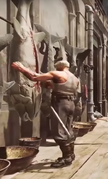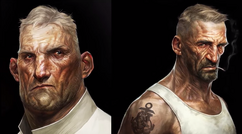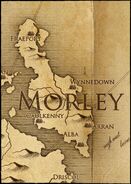
A map of Morley.
Morley is one of the four main islands of the Empire of the Isles, located northeast of Gristol and east of Tyvia. The capital city of Morley is Wynnedown, on the eastern coast. The isle has a wet, gloomy climate, but its people are hardy and independent-minded. It is ruled jointly by a king and a queen.[1] The kingdom's main policing force is the Royal Morley Constabulary.[2]
History[]
According to legend, many years before the War of Four Crowns, civil war for power and resources tore apart the Southern half of Morley. Outside what is now the city of Arran, a battle occurred, killing many Morleyans, and littering the fields with blood and corpses. Amidst the carnage, two witches waded through the bodies, with no weapon being able to touch the both of them. With a simple gesture, they forced both opposing armies to their knees. In the aftermath, they chose a boy and a girl from both sides, and led the two onto a large boulder that erupted from the earth. There, they crowned the first monarchs of Morley, ending the war and returning peace to the island.[3]
During and after the War of Four Crowns, which ended in 1625, Morley resisted the efforts of Gristol to assimilate the islands into the Empire, holding out longer than Tyvia and Serkonos. Repeated assaults and assassination attempts by Morleyans towards the end of the conflict necessitated further fortification of Dunwall Tower and the creation of the Royal Protector position.[4]
On the 27th Day, Month of Nets in 1801, the ESV Ridgegate was burned at Wynnedown.[5] It could be linked to the beginning of the Morley Insurrection.

Many Morleyans emigrated to Karnaca due to famine in their native land. With many undertaking manual labor jobs in the city.
The Morley Insurrection[]
The Morley Insurrection was a violent uprising of the kingdom of Morley against the rule of the Empire. It began on the 1st Day of the Month of High Cold, 1801. The conflict culminated with the assassination of the Empress Larisa Olaskir on the 8th Day of the Month of Clans. While minor strikes and riots occurred prior to 1801 across the Empire, the armed conflict only began that year. The stated reason behind the war was the harsh exploitation of the Morleyan working class by the wealthy families of the mercantile class who visited Dunwall and other parts of Gristol.[6] It ended officially on the 15th day of the Month of Seeds, 1802.
Warfare between Gristol and Morley was largely conducted by sea, with privateers raiding supplies and clashes between naval vessels from both sides. No land was officially taken or held, and the handful of land strikes by Morley rebels employed invasive stealth tactics. Using the decaying sewer systems of Dunwall extensively, they infiltrated and struck at the heart of the Empire.[7][5][6] Admiralty and the Fleet, a history of the naval power of Gristol, suggests that Gristol's victory over Morley was due in large part to its superior navy. Another factor was the Empire's superior economic base.[6] During the revolt, the Empire fortified Kingsparrow Island to protect the capital from attack by the sea,[8] and Dunwall Tower was similarly strengthened.
Consequences and Emigration[]
In the aftermath of the Morley Insurrection, famine was officially declared in 1803. Many settlers emigrated from Morley to Karnaca as a result, lured by the promise of jobs in the fisheries and the recently revitalized silver mining industry.[5] They built their village at Clemente Landing and contributed to Karnaca's newfound wealth. The village however, due to its distance with the city center, was mostly forgotten by the rich Gristolian investors who contributed to the Karnaca's modern urbanization[9] Aramis Stilton, a settler and miner in Karnaca from a poor family in Caulkenny, eventually made his way to the top of the mining industry, becoming the owner and manager of his own mines.
Morleyans in the other Nations were not so lucky. Although the conflict ended, the exploitation of the Morleyan working class did not in Dunwall. Those who were lured by the newly booming whaling industry were worked to the bones by companies like Greaves Lightning Oil. Prisoners of war were exploited in the factory of Coldridge Prison in the guise of serving their sentence. Social unrest in the Morleyan working class in Dunwall led to the March of the Oilbloods in 1827, which forced Luke Greaves to agree to new labor proposals, and the assassination of Coldridge Prison's owner, Julie Coldridge.[10]
To this day, the Morleyans across the Empire still harbor independent leanings. They may occasionally brandish the Insurrection's old flag during bouts of unrest.
In Dishonored and Dishonored 2[]
Morley, like the other Isles, refused to send aid to Dunwall during the Rat Plague in 1837.[11] In 1852, Wyman wrote in a letter to Emily that Morley seemed on the verge of going to war against Gristol in the wake of Delilah's coup.[12]
People and Culture[]

Two Morleyan men.
Morley is jointly ruled by a king and queen who possess equal authority. The co-monarchs marry each other for the sole purpose of maintaining the nation's delicate balance of political power in accordance with tradition and official protocol.[13]
It is noted that, despite the isle's dreary climate, the people of Morley are spirited and creative, with a rich history of "poets, musicians and philosophers." Intellectuals and artists can be found "even among the poorest folk", and Morleyans take great pride in hosting the prestigious University of Wynnedown, one of the foremost centers of learning in the Empire. However, the fact that most Morleyans cannot afford to attend an institution regarded as their national treasure is a source of resentment against the Gristolian and Tyvian aristocrats.[14] According to legend, Morley's cultural emphasis on learning and the arts originates from a bargain made with a coven of witches who originally controlled the land on which Wynnedown was built. The "Witches of Wynnedown" agreed to let the Morleyan people have the land for as long as they were able to create and learn. Some believe that the witches still live near Wynnedown, and are perpetually watching the Morleyans to ensure they uphold their ancient compact.[3]
The people of Morley are also fiercely independent, which was likely a contributing factor of the Morley Insurrection. After the revolt ended in the Empire's favor, the Morley people would continue to harbor pro-Independence feelings.[15] Groups such as the Ox Tongues gang attract people who share the goal of evicting the Empire from their island by any means necessary.[3]
Physically the native ethnic people of Morley are noted by other islanders for their tall height, bulkiness, and blonde hair.[16]
Morley is renowned for its food culture. The Isle of Morley suggests that it focuses largely on hearty foods, such as stews and roasted meats, and the author of Customs and Food of Morley makes special mention of Morley's infamous "jellied ox tongue".[17] The book The Distillery District notes that Morley boasts several highly valued brands of alcohol, including King Street Brandy.[18] Morley supplies the majority of food consumed by Tyvia, and also exports a considerable amount to Gristol and Serkonos. Despite this agricultural abundance, famine and poverty have persisted in Morley since the Insurrection, causing many Morleyans to emigrate to other parts of the Empire to make a living.[19]
Morley celebrates at least one national festival, called the Festival of Churners - the author of Customs and Food of Morley notes in particular the "high banners, bare feet, and red robes" present at the event[17] - and may participate in the Fugue Feast, though this has not been confirmed.
Locations[]
Major Cities[]
Trivia[]
- Morley is heavily based on Scotland and Ireland, with several city names bearing similarities to real-world Irish and Scottish places.
- According to developer Harvey Smith, the Morley Insurrection was heavily inspired by the various historical Irish rebellions throughout history and the Irish Potato Famine. The famine saw thousands of Irish citizens emigrate to other nations.[citation needed]
- Many Morleyan immigrants in Karnaca can be found at the cities docks working in the fishing industry. Morleyan immigrants can also be found as members of criminal gangs such as the Howlers and also as members of the Serkonian Grand Guard. It is also possible that Morleyans form the bulk of the population and workforce of Shindaerey North Quarry as the names of its inhabitants include Connor, Niall, and Siobhan, all Irish names.
- While the position of Royal Spymaster was originally a governmental secret within the Empire, the acting Spymaster during the Morley Insurrection played such a large role in ending the conflict that the position became publicly acknowledged thereafter.[20]
- Crushed Morley orchids are speculated to be a key ingredient in both Sokolov's Elixir and Piero's Spiritual Remedy.
- Half of Emperor Finlay Morgengaard's first whaling fleet went down near Arran.
- Of the food that Emily Kaldwin and Corvo Attano can consume to regain health, one item is specifically attributed to each nation in the Empire; Morley's is the Morley Apple.
- While little is known about the wildlife of Morley, there are no species like bloodflies there.
- The Morley Gallery of History and Sculpture possesses works of many of the greatest artists across the Empire, including Anton Sokolov's paintings. The gallery also displays items of "unusual quality" as well as "historical oddities".[21]
- Morleyan Overseers are mentioned to wear masks reminiscent of dental mannequin heads, according to Emily Kaldwin.
- Morleyan alabaster is reputed for its white texture. [22]
- Paolo prefers Morley steel for the Howlers Gang blades.[23]
- "Kom nor" means "Duck!" in Morleyan.[24]
Gallery[]
References[]
- ↑ Developer Commentary – Government
- ↑ Dishonored: The Return of Daud, Chapter 26
- ↑ 3.0 3.1 3.2 Dishonored Roleplaying Game, pp. 206,207
- ↑ The Tower of Dunwall
- ↑ 5.0 5.1 5.2 Dishonored: The Dunwall Archives
- ↑ 6.0 6.1 6.2 Dishonored Roleplaying Game, p.164
- ↑ The Sewers Beneath Dunwall
- ↑ The Lighthouse
- ↑ Dishonored Roleplaying Game, p.180
- ↑ The Oil Trail
- ↑ Dishonored - Returning Home
- ↑ Answer from Wyman
- ↑ Dishonored: The Veiled Terror
- ↑ Dishonored Roleplaying Game, p.204
- ↑ The Isle of Morley
- ↑ Dishonored 2 - Creating Karnaca
- ↑ 17.0 17.1 Customs and Food of Morley
- ↑ The Distillery District (book)
- ↑ Dishonored Roleplaying Game, pp. 203, 207
- ↑ The Royal Spymaster
- ↑ Proposal from Curator Haden
- ↑ Dishonored: The Corroded Man, p.13
- ↑ The Clockwork Mansion
- ↑ Dishonored Roleplaying Game, p. 290
World of the Dishonored franchise | |
|---|---|
| Geography |
The Isles (Gristol • Morley • Serkonos • Tyvia) • Dunwall • Karnaca • Pandyssian Continent |
| History |
The Loyalist Conspiracy • Rat Plague • Siege of White Cliff • Timeline • The Great Burning |
| Beliefs | |
| Authority |
City Watch • Empire of the Isles • Grand Guard • Warfare Overseers |
| Science | |
| Documents | |

